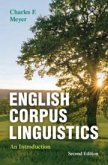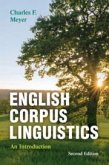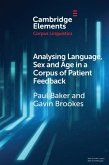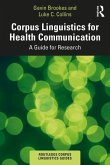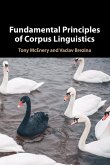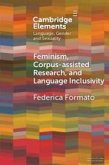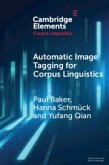Data and Methods in Corpus Linguistics
Herausgeber: Schützler, Ole; Schlüter, Julia
Data and Methods in Corpus Linguistics
Herausgeber: Schützler, Ole; Schlüter, Julia
- Broschiertes Buch
- Merkliste
- Auf die Merkliste
- Bewerten Bewerten
- Teilen
- Produkt teilen
- Produkterinnerung
- Produkterinnerung
Bringing together a team of leading experts, this uniquely designed book surveys and compares an array of methods and approaches in corpus linguistic research to stimulate critical discussion of recent developments. This timely volume will be essential reading for linguists interested in advanced corpus linguistic approaches to variation and change.
Andere Kunden interessierten sich auch für
![English Corpus Linguistics English Corpus Linguistics]() Charles F. Meyer (Boston University of Massachusetts)English Corpus Linguistics81,99 €
Charles F. Meyer (Boston University of Massachusetts)English Corpus Linguistics81,99 €![English Corpus Linguistics English Corpus Linguistics]() Charles F. Meyer (Boston University of Massachusetts)English Corpus Linguistics28,99 €
Charles F. Meyer (Boston University of Massachusetts)English Corpus Linguistics28,99 €![Analysing Language, Sex and Age in a Corpus of Patient Feedback Analysing Language, Sex and Age in a Corpus of Patient Feedback]() Paul Baker (Lancaster University)Analysing Language, Sex and Age in a Corpus of Patient Feedback22,99 €
Paul Baker (Lancaster University)Analysing Language, Sex and Age in a Corpus of Patient Feedback22,99 €![Corpus Linguistics for Health Communication Corpus Linguistics for Health Communication]() Gavin BrookesCorpus Linguistics for Health Communication42,99 €
Gavin BrookesCorpus Linguistics for Health Communication42,99 €![Fundamental Principles of Corpus Linguistics Fundamental Principles of Corpus Linguistics]() Tony McEnery (Lancaster University)Fundamental Principles of Corpus Linguistics30,99 €
Tony McEnery (Lancaster University)Fundamental Principles of Corpus Linguistics30,99 €![Feminism, Corpus-assisted Research and Language Inclusivity Feminism, Corpus-assisted Research and Language Inclusivity]() Federica Formato (University of Brighton)Feminism, Corpus-assisted Research and Language Inclusivity22,99 €
Federica Formato (University of Brighton)Feminism, Corpus-assisted Research and Language Inclusivity22,99 €![Automatic Image Tagging for Corpus Linguistics Automatic Image Tagging for Corpus Linguistics]() Paul Baker (Lancaster University and Zhejiang Gongshang University)Automatic Image Tagging for Corpus Linguistics22,99 €
Paul Baker (Lancaster University and Zhejiang Gongshang University)Automatic Image Tagging for Corpus Linguistics22,99 €-
-
-
Bringing together a team of leading experts, this uniquely designed book surveys and compares an array of methods and approaches in corpus linguistic research to stimulate critical discussion of recent developments. This timely volume will be essential reading for linguists interested in advanced corpus linguistic approaches to variation and change.
Produktdetails
- Produktdetails
- Verlag: Cambridge University Press
- Seitenzahl: 373
- Erscheinungstermin: 13. März 2025
- Englisch
- Abmessung: 226mm x 148mm x 22mm
- Gewicht: 546g
- ISBN-13: 9781108731034
- ISBN-10: 1108731031
- Artikelnr.: 72489434
- Herstellerkennzeichnung
- Libri GmbH
- Europaallee 1
- 36244 Bad Hersfeld
- gpsr@libri.de
- Verlag: Cambridge University Press
- Seitenzahl: 373
- Erscheinungstermin: 13. März 2025
- Englisch
- Abmessung: 226mm x 148mm x 22mm
- Gewicht: 546g
- ISBN-13: 9781108731034
- ISBN-10: 1108731031
- Artikelnr.: 72489434
- Herstellerkennzeichnung
- Libri GmbH
- Europaallee 1
- 36244 Bad Hersfeld
- gpsr@libri.de
List of figures; List of tables; List of contributors; Acknowledgements;
Introduction: Comparative Approaches to Data and Methods in Corpus
Linguistics Julia Schlüter and Ole Schützler; Part I. Corpus dimensions and
the viability of methodological approaches; 1.Comparing standard reference
corpora and Google Books Ngrams: Strengths, limitations and synergies in
the contrastive study of variable h- in British and American English Lukas
Sönning and Julia Schlüter; 2. Comparing approaches to phonological and
orthographic corpus formats: Revisiting the Principle of Rhythmic
Alternation Sabine Arndt-Lappe and Sebastian Hoffmann; Part II. Selection,
calibration and preparation of corpus data; 3. Comparing approaches to
(sub-)register variation: The 'press editorials' sections in the British,
Canadian and Jamaican components of ICE Fabian Vetter; 4. Comparing
baselines for corpus analysis: Research into the get-passive in speech and
writing Sean Wallis and Seth Mehl; 5. Comparing study designs and
down-sampling strategies in corpus analysis: The importance of speaker
metadata in the BNCs of 1994 and 2014 Lukas Sönning and Manfred Krug; Part
III. Perspectives on multifactorial methods; 6. Comparing generalised
linear mixed-effects models, generalised linear mixed-effects model trees
and random forests: Filled and unfilled pauses in varieties of English
Tobias Bernaisch; 7. Comparing logistic regression, multinomial regression,
classification trees and random forests applied to ternary variables:
Three-way genitive variation in English Matthew Fahy, Jesse Egbert,
Benedikt Szmrecsanyi and Douglas Biber; 8. Comparing Bayesian and
frequentist models of language variation: The case of help + (tö)infinitive
Natalia Levshina; 9. Comparing methods for the evaluation of clusters in
multidimensional analyses: Concessive constructions in varieties of English
Ole Schützler; Part IV. Applications of classification-based approaches;
10. Comparing corpus-driven and corpus-based approaches to diachronic
variation: Grammatical changes in Late Modern and Present-Day English
Gerold Schneider; 11. Comparing annotation types and n-gram sizes: A case
study of the German modal particles ja and doch and their English reflexes
Volker Gast; Index.
Introduction: Comparative Approaches to Data and Methods in Corpus
Linguistics Julia Schlüter and Ole Schützler; Part I. Corpus dimensions and
the viability of methodological approaches; 1.Comparing standard reference
corpora and Google Books Ngrams: Strengths, limitations and synergies in
the contrastive study of variable h- in British and American English Lukas
Sönning and Julia Schlüter; 2. Comparing approaches to phonological and
orthographic corpus formats: Revisiting the Principle of Rhythmic
Alternation Sabine Arndt-Lappe and Sebastian Hoffmann; Part II. Selection,
calibration and preparation of corpus data; 3. Comparing approaches to
(sub-)register variation: The 'press editorials' sections in the British,
Canadian and Jamaican components of ICE Fabian Vetter; 4. Comparing
baselines for corpus analysis: Research into the get-passive in speech and
writing Sean Wallis and Seth Mehl; 5. Comparing study designs and
down-sampling strategies in corpus analysis: The importance of speaker
metadata in the BNCs of 1994 and 2014 Lukas Sönning and Manfred Krug; Part
III. Perspectives on multifactorial methods; 6. Comparing generalised
linear mixed-effects models, generalised linear mixed-effects model trees
and random forests: Filled and unfilled pauses in varieties of English
Tobias Bernaisch; 7. Comparing logistic regression, multinomial regression,
classification trees and random forests applied to ternary variables:
Three-way genitive variation in English Matthew Fahy, Jesse Egbert,
Benedikt Szmrecsanyi and Douglas Biber; 8. Comparing Bayesian and
frequentist models of language variation: The case of help + (tö)infinitive
Natalia Levshina; 9. Comparing methods for the evaluation of clusters in
multidimensional analyses: Concessive constructions in varieties of English
Ole Schützler; Part IV. Applications of classification-based approaches;
10. Comparing corpus-driven and corpus-based approaches to diachronic
variation: Grammatical changes in Late Modern and Present-Day English
Gerold Schneider; 11. Comparing annotation types and n-gram sizes: A case
study of the German modal particles ja and doch and their English reflexes
Volker Gast; Index.
List of figures; List of tables; List of contributors; Acknowledgements;
Introduction: Comparative Approaches to Data and Methods in Corpus
Linguistics Julia Schlüter and Ole Schützler; Part I. Corpus dimensions and
the viability of methodological approaches; 1.Comparing standard reference
corpora and Google Books Ngrams: Strengths, limitations and synergies in
the contrastive study of variable h- in British and American English Lukas
Sönning and Julia Schlüter; 2. Comparing approaches to phonological and
orthographic corpus formats: Revisiting the Principle of Rhythmic
Alternation Sabine Arndt-Lappe and Sebastian Hoffmann; Part II. Selection,
calibration and preparation of corpus data; 3. Comparing approaches to
(sub-)register variation: The 'press editorials' sections in the British,
Canadian and Jamaican components of ICE Fabian Vetter; 4. Comparing
baselines for corpus analysis: Research into the get-passive in speech and
writing Sean Wallis and Seth Mehl; 5. Comparing study designs and
down-sampling strategies in corpus analysis: The importance of speaker
metadata in the BNCs of 1994 and 2014 Lukas Sönning and Manfred Krug; Part
III. Perspectives on multifactorial methods; 6. Comparing generalised
linear mixed-effects models, generalised linear mixed-effects model trees
and random forests: Filled and unfilled pauses in varieties of English
Tobias Bernaisch; 7. Comparing logistic regression, multinomial regression,
classification trees and random forests applied to ternary variables:
Three-way genitive variation in English Matthew Fahy, Jesse Egbert,
Benedikt Szmrecsanyi and Douglas Biber; 8. Comparing Bayesian and
frequentist models of language variation: The case of help + (tö)infinitive
Natalia Levshina; 9. Comparing methods for the evaluation of clusters in
multidimensional analyses: Concessive constructions in varieties of English
Ole Schützler; Part IV. Applications of classification-based approaches;
10. Comparing corpus-driven and corpus-based approaches to diachronic
variation: Grammatical changes in Late Modern and Present-Day English
Gerold Schneider; 11. Comparing annotation types and n-gram sizes: A case
study of the German modal particles ja and doch and their English reflexes
Volker Gast; Index.
Introduction: Comparative Approaches to Data and Methods in Corpus
Linguistics Julia Schlüter and Ole Schützler; Part I. Corpus dimensions and
the viability of methodological approaches; 1.Comparing standard reference
corpora and Google Books Ngrams: Strengths, limitations and synergies in
the contrastive study of variable h- in British and American English Lukas
Sönning and Julia Schlüter; 2. Comparing approaches to phonological and
orthographic corpus formats: Revisiting the Principle of Rhythmic
Alternation Sabine Arndt-Lappe and Sebastian Hoffmann; Part II. Selection,
calibration and preparation of corpus data; 3. Comparing approaches to
(sub-)register variation: The 'press editorials' sections in the British,
Canadian and Jamaican components of ICE Fabian Vetter; 4. Comparing
baselines for corpus analysis: Research into the get-passive in speech and
writing Sean Wallis and Seth Mehl; 5. Comparing study designs and
down-sampling strategies in corpus analysis: The importance of speaker
metadata in the BNCs of 1994 and 2014 Lukas Sönning and Manfred Krug; Part
III. Perspectives on multifactorial methods; 6. Comparing generalised
linear mixed-effects models, generalised linear mixed-effects model trees
and random forests: Filled and unfilled pauses in varieties of English
Tobias Bernaisch; 7. Comparing logistic regression, multinomial regression,
classification trees and random forests applied to ternary variables:
Three-way genitive variation in English Matthew Fahy, Jesse Egbert,
Benedikt Szmrecsanyi and Douglas Biber; 8. Comparing Bayesian and
frequentist models of language variation: The case of help + (tö)infinitive
Natalia Levshina; 9. Comparing methods for the evaluation of clusters in
multidimensional analyses: Concessive constructions in varieties of English
Ole Schützler; Part IV. Applications of classification-based approaches;
10. Comparing corpus-driven and corpus-based approaches to diachronic
variation: Grammatical changes in Late Modern and Present-Day English
Gerold Schneider; 11. Comparing annotation types and n-gram sizes: A case
study of the German modal particles ja and doch and their English reflexes
Volker Gast; Index.



